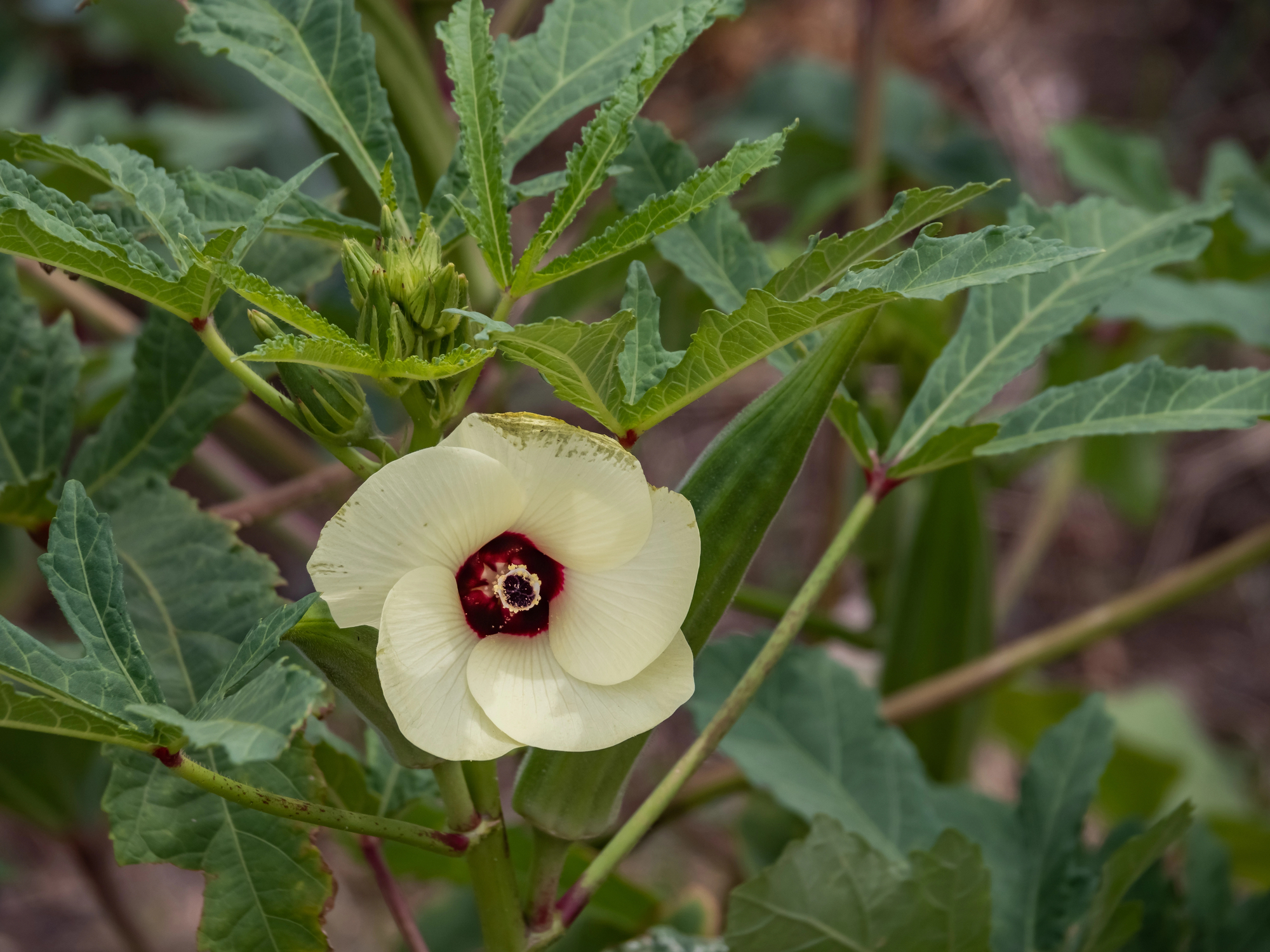Okra Donation Tracker
Quick Links: How & Where to Grow | Temperature | How to Care For | Harvest Signs | Harvesting | Pruning | Pests | Companions | Varieties | Preservation | Recipes | Michigan Tips | Fun Facts
🌱 How & Where to Grow Okra:
- Start indoors 4-6 weeks early or direct seed when soil reaches 70°F.
- Space plants 12-18 inches apart in rows 3 feet apart – okra grows tall!
- Soak seeds overnight before planting to improve germination.
- Plant seeds 1 inch deep in warm soil.
- Sunlight: Full sun (8+ hours) absolutely essential.
- Soil Type: Well-drained soil with pH 6.0-7.0.
- Soil Amendment: Rich in organic matter but tolerates poor soil better than most vegetables.
Okra is truly a heat-loving challenge in Michigan – success requires maximizing every warm day!
🌡️ Temperature Guidance:
Critical 70°F minimum soil. Needs 80-95°F days.
- Planting: Wait for consistent 70°F+ soil temperature – usually early June.
- Germination: Seeds won’t germinate below 65°F.
- Optimal growth: 85-95°F days with warm nights above 65°F.
- Growth completely stops below 60°F.
- Even light frost kills okra plants instantly.
In Michigan, think of okra as a July-August crop that needs every heat trick available!
💧 How to Care for:
- Consistent Moisture: Maintain even soil moisture but avoid overwatering.
- Watering: 1 inch weekly – okra is surprisingly drought-tolerant once established.
- Black Plastic Mulch: Essential in Michigan to warm soil and retain heat.
- Fertilizer: Side-dress monthly with balanced fertilizer once flowering begins.
- Support: Stake tall varieties in windy locations – plants can reach 6 feet!
📏 Harvest Signs:
2-4 inches long, 4-6 days after flowering. Daily harvest essential.
- Pods grow incredibly fast – check plants DAILY once production starts!
- Best quality when 2-4 inches long and bright green.
- Pods should snap easily when bent.
- Larger pods become tough and fibrous quickly.
- Harvest every 1-2 days to maintain production.
Missing just one day of harvest can result in woody, inedible pods!
🧺 Harvesting:
Cut with knife or pruners. Wear gloves and long sleeves – pods are prickly!
- Always cut rather than pull to avoid damaging plants.
- Harvest in morning when pods are crisp and cool.
- Use gloves – many varieties have spines that irritate skin.
- Regular harvesting stimulates more flower production.
- Don’t let pods mature – overripe pods signal plant to stop producing.
✂️ Pruning:
Top plants at 24 inches to encourage branching. Remove lower leaves as they yellow.
- Topping: When plants reach 24 inches, pinch growing tip to encourage side shoots.
- Lower leaf removal: Improves air circulation and reduces disease.
- Late season: Remove growing tips 4 weeks before frost to ripen existing pods.
- Damaged pods: Remove any that you miss to maintain production.
- Side shoots: Each produces additional flowers and pods.
🪲 Michigan Pests:
Aphids, Japanese beetles, corn earworms, root-knot nematodes.
- Aphids: Cluster on growing tips – blast off with water.
- Japanese beetles: Skeletonize leaves – hand-pick or use row covers.
- Corn earworms: Bore into pods – check regularly and destroy affected pods.
- Fusarium wilt: Soil disease – rotate crops and choose resistant varieties.
- Generally fewer pest problems than most vegetables due to tough leaves.
🫱🏽🫲🏼 Companions:
Good with peppers, eggplant, basil, cosmos.
- Other heat lovers share similar growing requirements.
- Basil may help repel aphids and other pests.
- Cosmos attract beneficial insects.
- Radishes can be planted early in okra space.
- Avoid planting near vine crops that might shade okra.
🌿 Varieties:
‘Red Burgundy’ (55 days), ‘Clemson Spineless’, ‘Annie Oakley’ (52 days).
- ‘Annie Oakley’: 52 days, compact 4 feet, heavy yields, good for Michigan.
- ‘Clemson Spineless’: 56 days, classic variety, less prickly, 4-5 feet tall.
- ‘Red Burgundy’: 55 days, ornamental red pods, 5 feet tall.
- ‘Jambalaya’: 50 days, very early, good for short seasons.
- ‘Baby Bubba’: 53 days, dwarf 3-4 feet, perfect for containers.
🫙 Preservation:
Freeze blanched. Dry. Pickle. Pressure can.
- Freezing: Blanch whole small pods 3 minutes, slice and blanch 2 minutes.
- Pickling: Traditional Southern pickled okra – stays crispy.
- Drying: Slice and dehydrate for soups and stews.
- Pressure canning: Only in tested recipes – never water bath.
- Fresh storage: Only 2-3 days in perforated bag in refrigerator.
🧑🏽🍳 Recipes:
Gumbo, fried okra, pickled okra, grilled okra, okra curry.
- Classic Louisiana gumbo – okra acts as natural thickener.
- Southern fried okra with cornmeal coating.
- Grilled whole okra with olive oil and sea salt.
- Indian bhindi masala (spiced okra curry).
- Roasted okra chips – healthy alternative to fried.
✋🏼 Michigan Tips:
- Raised beds essential – improves drainage and soil warming.
- Black plastic mulch can increase soil temperature 10°F.
- Warmest location – south-facing, protected from wind.
- Early varieties critical – choose 55 days or less.
- Start indoors in early May for transplanting June 1.
- Row covers early season help trap heat.
- Container growing allows moving to warmest spots.
🧠 Fun Facts:
- Related to hibiscus – flowers are similarly beautiful and edible!
- “Gumbo” comes from ki ngombo, the African word for okra.
- Okra seeds can be roasted and ground as a coffee substitute.
- Ancient Egyptians cultivated okra along the Nile.
- The sticky juice has been used to strengthen paper and textiles.
- Okra is technically a fruit, not a vegetable.
- World’s longest okra pod measured 20.87 inches!
- Michigan is at the northern limit for okra cultivation – our success is a real achievement!


0 Comments